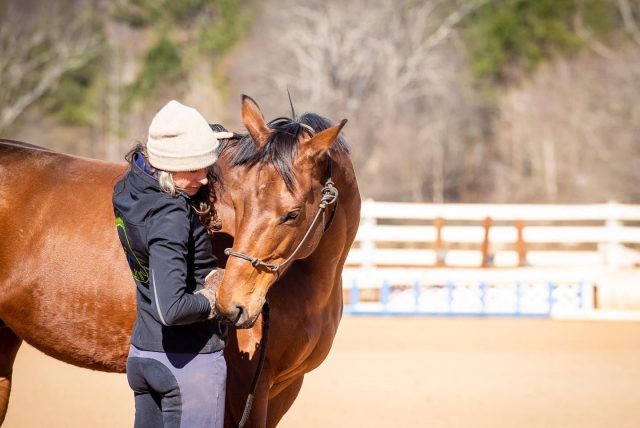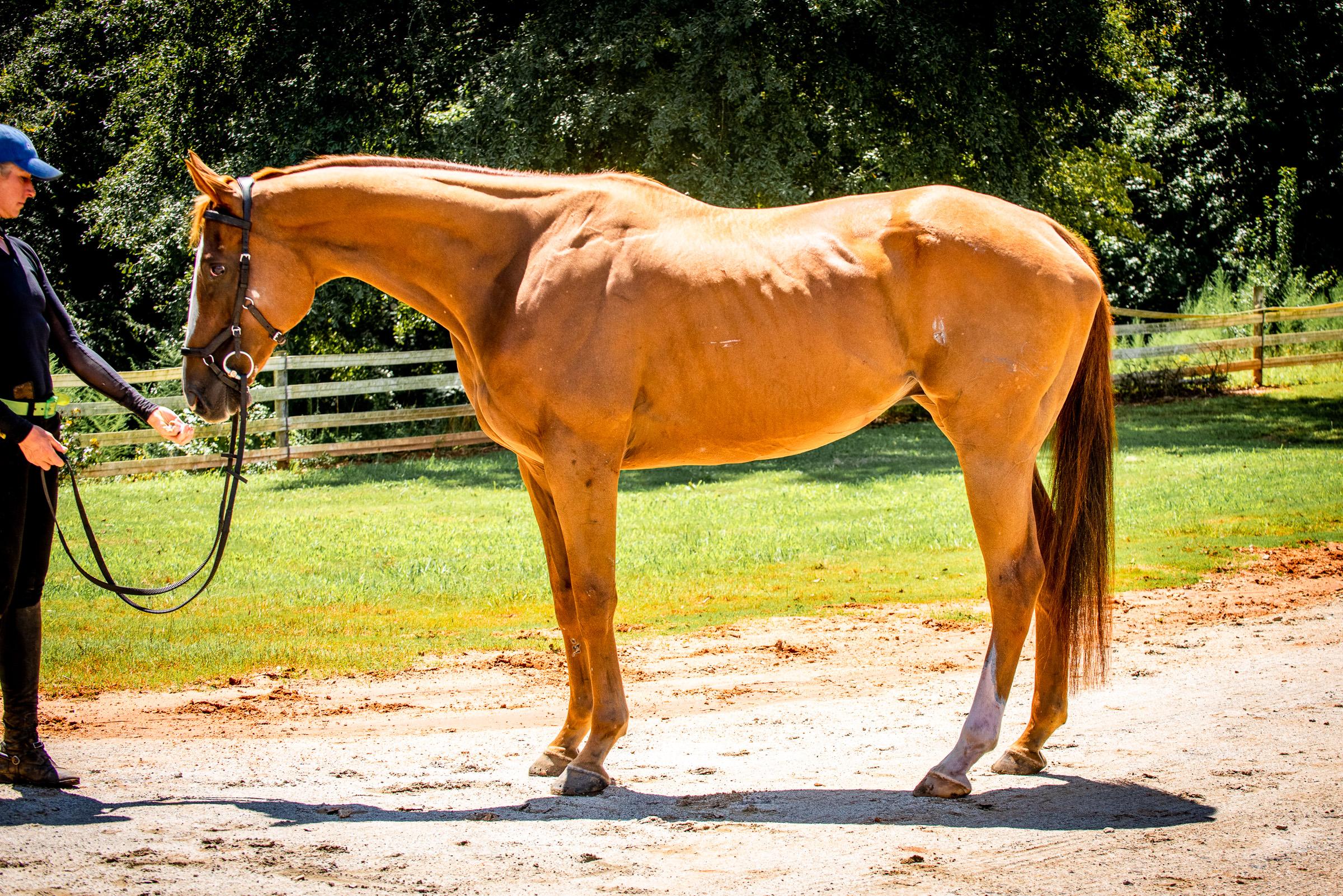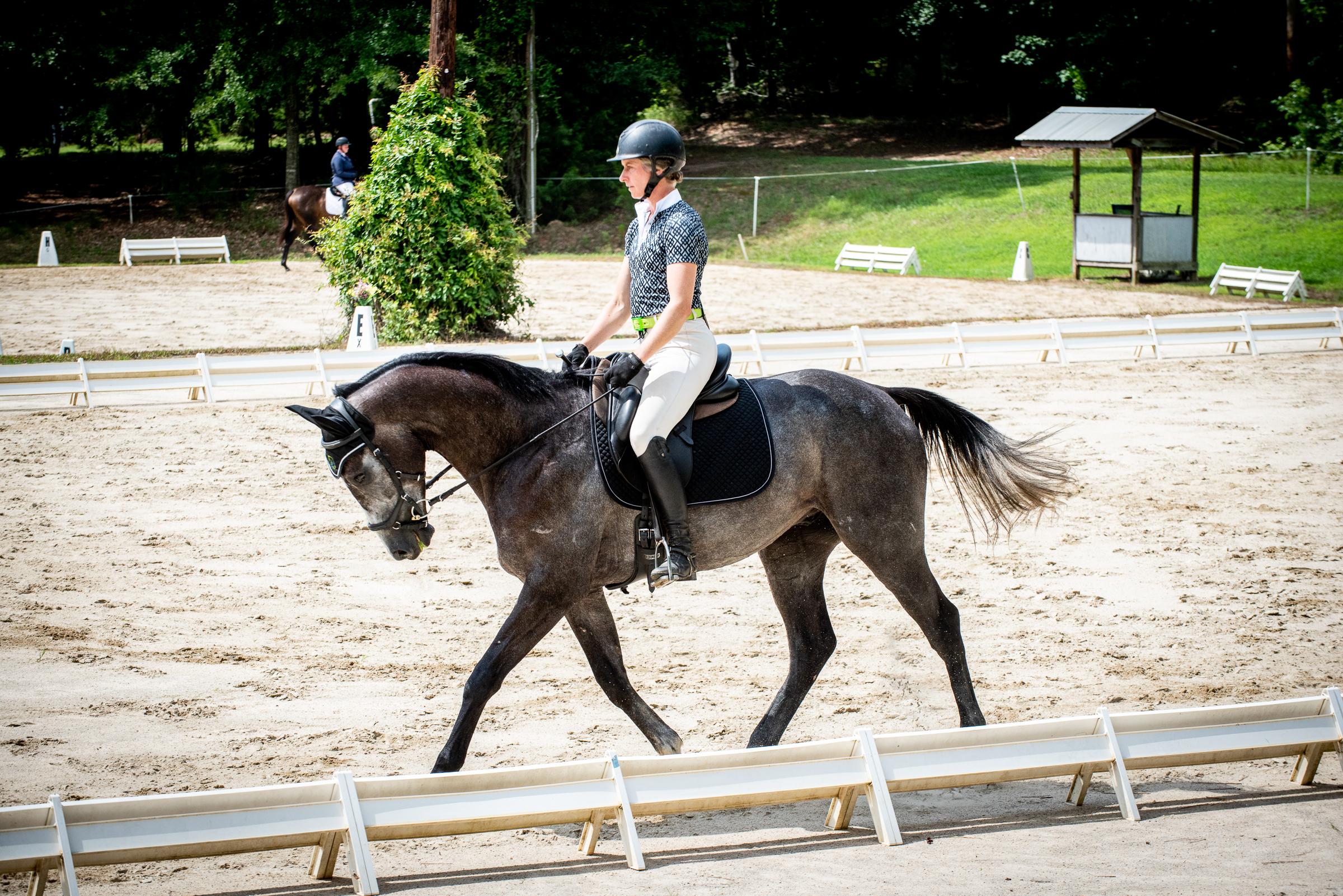
Thoroughbred Logic, Presented by Kentucky Performance Products: Three Ground Work Essentials
Today’s Thoroughbred Logic addresses three key ground work exercises: working on a loose lead, giving, and moving over.
Welcome to the next installment of Thoroughbred Logic. In this weekly series, Anthropologist and trainer Aubrey Graham, of Kivu Sport Horses, will offer insight and training experience when it comes to working with Thoroughbreds (although much will apply to all breeds). This week ride along as Aubrey discusses her logic on the importance of groundwork (and which groundwork is essential!).
Everyone has their own tactic for getting OTTBs restarted in their second careers. Some hop on and get training, some pony the horse into the new job, and some put in ample groundwork before stepping into the irons. To be fair, most trainers do some combination of the above… and inevitably, each horse requires their own tweaks to the program. Today I’ll address some very basic ground work that I use to establish the cues, the movement, and boundaries that we need to go forward.

Rhodie (Western Ridge) demonstrating “give” at a Thoroughbred Logic Clinic earlier this year. Photo by Audrey Mecklenburg.
Thoroughbreds come off the track and are for sale year-round, of course, and even though the 2025 Retired Racehorse Project’s Thoroughbred Makeover hasn’t yet taken place, many folks already are starting to think about picking up their next partner. The catch with that is, yes the horses right off the backside might need downtime, but they also can only have a total of 15 re-training rides off the track before the RRP’s “training start date” of December 1st to remain eligible for the following year’s competition. In other words, if folks are picking up horses now, they’re in a holding pattern until near December. Time for some turnout, letdown, and solid groundwork sessions.
The most essential aspect with these sessions is checking one’s sport-horse-specific expectation that has been gained over the years. Very few ex-racers will understand how to lunge like horses purpose bred and trained for the show world (I’ll address basic lunging next week). And depending on who trained them at and before the track, even fewer OTTBs will fully understand how to move their ribs and shoulders over and away from pressure. That said, some horses have been beautifully trained at and before their running careers and know well how to do these things. If you have one of those, thank their trainers, you’re a lucky human! Nevertheless — who knows? — these tips and exercises might still be helpful.
So let’s briefly run through a few of them:
1. Working on a loose lead
The first exercise lays the groundwork for the training exchanges that come after. This is the notion that all work on the ground is done on a relatively loose lead rope and through a relaxed body. I wrote about this in the “Thoroughbred Logic: Enough Rope” piece. The critical parts include maintaining clear boundaries and giving appropriate releases. Done correctly, most of these horses can come straight off the track and walk on a loose line within a day or two without dragging you around, or making you use your arm and shoulder/elbow to try to keep them next to you. Once you can walk, halt, jog, halt etc. around your farm and arena with them paying full attention to you and stopping with you like a well-trained dog, you’re in good shape to move on. I use these exercises as both training and relationship building with the horses. They’re goofy — that’s part of the point, no one said training had to be all serious all the time.
2. Give
The second exercise is the “give and shoulders over” movement. For this one, I stand at the horse’s shoulder with my shoulders squarely facing their side and a dressage whip in hand (sat against their wither) and gently tug on the rein (though this can be done well with a rope halter too) and say “give” until they bring their nose to my hip. As soon as they succeed, or come close, I drop their contact and reward them. (Quick note here: to each their own, but I don’t train with treats. These smart, manipulative critters will learn to pat you down for them in no time flat). A well-timed release is the most critical aspect and one needs to be ready to drop, leave them alone, and then reward as soon as they make the effort. I’ll do this a few times on both sides of their body before asking them to expand the exercise and “move over.”

Rhodie “gives” and moves “over” away from pressure – he has done this enough that he’ll move away from the pressure of one finger like a pro. Photo by Audrey Mecklenburg.
3. Shoulders over
Once I have them comfortable to configure their bodies into the “give” position, I will tap the crop gently on their shoulder and ask them to cross over up front and step sideways. As soon as they take one good step across their body, I’ll drop the contact and let them relax (with ample scratches and “good” as a reward). Once they can do this from both sides easily, you should be able to control the movement without the guidance of the crop and instead, just touch their shoulder to move them over.
The video below was hastily created for a client last year to demonstrate what I was trying to teach. It is not the best, but gives a pretty good idea of the concepts.
The great thing about smart horses is that those brain cells come in handy with this stuff. It usually doesn’t take them too long to learn this set of exercises. And even better, the concepts are super easy to apply under saddle. To translate from ground to tack, I use the same verbal cues while adding in the concept of leg as impulsion and direction not just “go.” I’ll put the crop against their shoulder, or literally tap a finger, and use the same cue (“over”) while applying inside leg and drawing them onto the outside rein. The exercise also helps them to put weight on their outside hind and free up the inside hind leg. In short, they learn to “sit” through the hind-end based upon your cues, making them more capable of balancing, especially on circles and turns.
Rhino (Classy Cowboy) made a great example of this, though we got next-to-no media before he sold. This gorgeous, successful racehorse was slightly tight off the track, but full of try. I taught him the ground work and then spent 10 minutes retraining it in the tack at a walk. It took very little time before the hollow, giraffe-going chestnut dropped his head, came over his back and took a big breath. Good Rhino. I was impressed, but it goes to show just how simple it can be sometimes when the communication is clear enough and the horse wants nothing but to try to get the right answer.

Rhino (Classy Cowboy) showing his one-week at Kivu glow up. He sold before we could get more media, but I cannot wait to see how this guy fills out and trains up with his new owner. Photo by Alanah Giltmier.
Tuck’s photos (below) stand in for those we don’t have of Rhino; both horses went through very similar transitions. As shown in the first photo, both were hollow and inverted with a leaning shoulder during initial rides, but with time, turnout, ground work, and in-track translation of the concepts, they become soft, balanced, and round.

This is a pretty solid “before” picture with Tuck (Louisiana Bling). Taken in April 2022, Tuck didn’t know how to move his shoulders and ribs away from pressure. Photo by Kelly Robison.

Same gray horse, more skilled ability to get his ribs and shoulders out of the way and therefore push up and over his back from behind. Photo by Cora Williamson.
Overall, these quick exercises might not fix all of the Thoroughbred training problems of the world, but they lay a foundation for clear communication, fairness, and a positive relationship. Moreover, they help the horses to step outside of a track mindset to understand what in the world we strange sporthorse people are asking. So if you’re like me, when life gives you lemons like this week, screw making lemonade, go buy some horses and get started on the ground. Both the horses and your heart will thank you later.
About Kentucky Performance Products, LLC:
Omega-3 fatty acids have been proven to reduce skin inflammation and mitigate allergic response. Contribute delivers both plant and marine sources of beneficial omega-3 fatty acids. Feed one to two ounces per day, depending on severity of the allergy.
Need tips on how to manage allergies? Check out this KPP infographic: Got Allergies?
The horse that matters to you matters to us®. KPPusa.com






